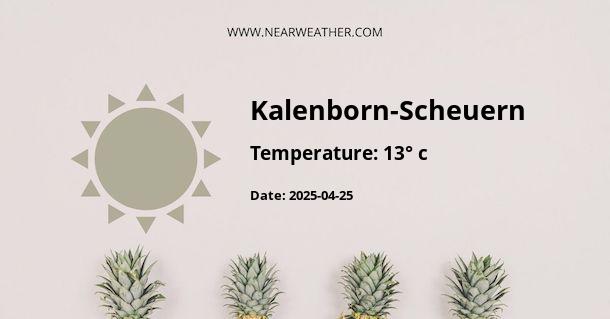Exploring the Climate and Weather of Kalenborn-Scheuern, Germany
Kalenborn-Scheuern, a serene locality in the picturesque region of Rhineland-Palatinate, Germany, experiences a climate that is characterized by its temperate and generally mild weather patterns. Understanding the area's climatic conditions can be beneficial for visitors, residents, and local businesses alike. In this detailed exploration, the climate and weather patterns of Kalenborn-Scheuern will be discussed, underpinned by statistical data that illuminate the unique meteorological traits of this charming German enclave.
Overview of Kalenborn-Scheuern’s Climate
According to the Köppen climate classification, which is a widely-used system to categorize the world's climate regimes, Kalenborn-Scheuern falls under the Cfb category, indicative of a temperate oceanic climate. This classification is characterized by the absence of a dry season, with precipitation distributed evenly throughout the year, and warm, sometimes hot summers.
Seasonal Weather Patterns
Spring
With the advent of spring, Kalenborn-Scheuern witnesses a gradual increase in temperature. Blooms decorate the landscapes, and there is a noticeable increase in daylight hours.
- Temperature Range: Average temperatures in spring may vary from 5°C to 15°C.
- Precipitation: Rainfall is moderate, averaging around 50 mm per month.
- Daylight: Daylight hours increase from about 11 hours in early March to approximately 16 hours by late May.
Summer
Summers are generally mild to warm, with the rare heatwave pushing temperatures into uncomfortable realms.
- Temperature Range: Average daytime highs range from 20°C to 25°C, while nighttime lows may drop to around 10°C.
- Precipitation: Although rainfall is relatively less than other seasons, summer can occasionally experience heavy downpours or thunderstorms.
- Daylight: The longest day occurs around the summer solstice, with nearly 17 hours of daylight.
Autumn
Autumn brings with it a tapestry of colorful foliage. Temperatures begin to decline as the season progresses.
- Temperature Range: Temperatures average between 5°C and 14°C, gradually decreasing as winter approaches.
- Precipitation: Rainfall increases, contributing to the damp and misty conditions often associated with the season.
- Daylight: Daylight hours shorten significantly, from around 14 hours in early September to roughly 8 hours by late November.
Winter
Winters are generally cold, with the possibility of snow, especially in January and February.
- Temperature Range: Average temperatures hover around 0°C to 3°C. Negative temperatures are common at night, leading to frosty conditions.
- Precipitation: Snowfall occurs intermittently, while most of the winter precipitation is in the form of rain or sleet.
- Daylight: The winter solstice brings the shortest day, with about 8 hours of daylight.
Annual Weather Statistics
Note: The meteorological data provided here are averages and can vary from year to year. They serve as a general guideline for the typical climate patterns of Kalenborn-Scheuern.
Temperature and precipitation play a crucial role when analyzing the climatic conditions of Kalenborn-Scheuern throughout the year. The following table provides a succinct overview of the monthly averages and extremes that have been observed historically in this locale:
| Month | Temperature (°C) | Precipitation (mm) | Daylight Hours |
|---|---|---|---|
| January | 0-3 | 60-80 | 8 |
| February | 1-4 | 50-70 | 10 |
| March | 4-9 | 70-90 | 12 |
| April | 8-13 | 60-75 | 14 |
| May | 12-18 | 70-85 | 16 |
| June | 15-21 | 80-100 | 17 |
| July | 17-24 | 70-90 | 16 |
| August | 17-23 | 70-85 | 15 |
| September | 13-19 | 80-95 | 14 |
| October | 9-14 | 70-90 | 11 |
| November | 4-8 | 80-100 | 9 |
| December | 1-4 | 80-100 | 8 |
Extreme Weather Events and Climate Change
Climate change has become a focal point in discussions about future weather patterns, and Kalenborn-Scheuern is not immune to its effects. Although the region typically experiences moderate weather, the prevalence of extreme weather events, such as severe storms, heatwaves, and heavy precipitation, has been on a gradual rise. The implications of these events include disrupted ecosystems, challenges in agriculture, and increased risks of flooding.
Rising Temperatures
An upward trend in average temperatures has been observed, which could potentially lead to hotter, longer summers and shorter winters. This shift could alter the local flora and fauna and affect traditional farming cycles in the region.
Increase in Precipitation Extremes
Increased precipitation intensity and variability may result in more frequent and severe flooding. This has implications for infrastructure, requiring more robust water management systems to cope with these extremes.
Preparation for Weather Conditions
The knowledge of Kalenborn-Scheuern's climate and weather patterns is essential for residents and visitors who wish to prepare adequately for their daily activities or travel plans. Wearing appropriate clothing and carrying necessary gear can mitigate the discomfort caused by unexpected weather changes. Moreover, awareness of potential extreme weather events allows for the development of contingency plans to ensure safety and minimize damage.
Conclusion
In conclusion, Kalenborn-Scheuern’s climate offers a rich tapestry of seasonal changes, each with its charm and challenges. From the vivacity of spring to the stillness of winter, understanding and preparing for the region’s climate is key for anyone looking to engage with this German locale harmoniously. Regular consultation of detailed meteorological forecasts is recommended to stay informed about any potential deviations from the average weather patterns discussed in this article.
A - Kalenborn-Scheuern's Latitude is 50.250000 & Longitude is 6.600000.
A - Weather in Kalenborn-Scheuern is 13° today.
A - Climate Conditions in Kalenborn-Scheuern shows scattered clouds today.
A - Humidity in Kalenborn-Scheuern is 63% today.
A - Wind speed in Kalenborn-Scheuern is 14.36 km/h, flowing at 17° wind direction. today.
